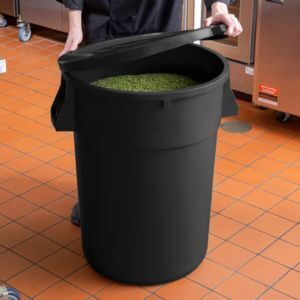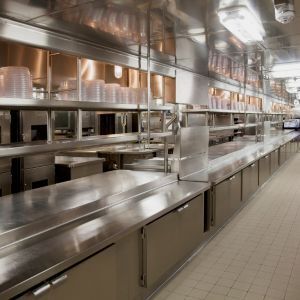Why Every Commercial Kitchen in NZ Needs Food-Grade Storage Bins
In the high-pace world of commercial kitchens, every detail matters. From hygiene to workflow to cost control, small improvements can yield big dividends. One area that is often overlooked but is absolutely vital is the use of true food-grade storage bins. In this article we’ll explain why these bins deserve a permanent place in your back-of-house and outline the key benefits for New Zealand commercial kitchens.
What do we mean by “food-grade” storage bins?
A food-grade storage bin is a container that is specifically designed and certified/suitable for storing food — whether ingredients, prepared food or bulk items — without risk of harmful contamination, deterioration or cross-contamination.
When running a commercial kitchen, using food-grade bins means using materials and designs that meet regulations, are durable, cleaned properly, and maintain food safety standards.
The key benefits of food-grade storage bins
Here are five major reasons every commercial kitchen in NZ should invest in them:
1. Enhanced food-safety & regulatory compliance
Proper food storage is fundamental to food safety: it reduces the risk of foodborne illnesses, cross-contamination and spoilage.
Food-grade bins support hygiene protocols by providing sealed, dedicated containers for ingredients, preventing leaks, physical contaminants and bacterial growth.
In New Zealand, food-safety regulations such as those under the Food Act require operations to demonstrate safe storage. Having high-quality food-grade bins helps you show due diligence.
2. Better organisation & workflow efficiency
Commercial kitchens move fast. Having the right storage bins means you can organise by ingredient, chef station, shelf, FIFO (first-in, first-out) rotation and more.
Colour-coding, labelling and stackable food-grade bins make it easier for your team to find what they need, reducing search times and errors.
3. Reduced waste and improved shelf-life
The right bin helps protect food from moisture, air, pests, spoilage and mis-labelling.
Less waste means less cost, better margins — especially important in commercial kitchens where food-cost pressures are constant.
4. Space-saving & operational cost control
In a commercial kitchen, space is at a premium. Food-grade bins designed with stackability, clear labelling and efficient shapes (e.g., square vs round) help you get more out of the same area.
Better space-utilisation translates into lower overheads, improved logistics, faster service and fewer bottlenecks.
5. Durability & long-term value
Food-grade bins designed for commercial use (as opposed to domestic tubs) use durable materials, are easier to clean/sanitise, resist warping or staining, and withstand harsh kitchen environments.
Paying a little more up front for the right bin often pays for itself in fewer replacements, less downtime and better hygiene compliance.
What to look for: Choosing the right food-grade bin for your NZ commercial kitchen
Here are must-have features and considerations when selecting storage bins:
-
Material: Look for food-safe plastics (HDPE, polypropylene) or stainless steel (for wet/hot uses).
-
Certification/Marking: Ensure bins are clearly labelled “food-grade” or have relevant standards.
-
Size & shape: Choose sizes that suit your space and storage volume. Square bins often save space over round ones.
-
Sealable lids: A tight-fitting lid helps maintain freshness, keeps pests out, and reduces cross-contamination.
-
Stackable/nestable design: For space-efficiency and easy access.
-
Transparent or labelled sides: Helps staff identify contents quickly and supports FIFO.
-
Ease of cleaning: Smooth surfaces, minimal crevices, dishwasher-safe if required.
-
Mobility/handling: Consider bins with handles or wheels if moved frequently.
-
Temperature tolerance: Ensure material suits fridge/freezer or hot kitchen zones.
Research & evidence: Why food-grade storage matters
-
A 2021 review titled Food packaging’s materials: A food safety perspective highlights the risks of chemical migration from packaging materials into food, especially under poor storage conditions. This reinforces the importance of certified, safe storage bins. For commercial kitchens, this means selecting bins made of food-safe materials that won’t compromise food quality, especially when storing temperature-sensitive items or items in bulk.
-
A 2024 editorial titled Plastic Food Container Safety outlines how even some containers marketed for food use may leach chemicals if not properly designed or used, underlining the need for rigorously tested food-grade options. In a high-turnover kitchen environment, where bins are reused daily and exposed to cleaning chemicals or heat, investing in proven, non-reactive materials helps reduce food safety risks and protect public health.
Why this matters especially in New Zealand
In the NZ food-service industry, operational margins are tight, regulatory standards are strict and reputation matters. Having the right infrastructure—such as food-grade storage bins—can differentiate your business in terms of hygiene, service speed and cost control.
Given the often compact nature of NZ kitchens (especially cafés, catering vans, regional hubs), maximising storage efficiency and safety is even more critical.
Final checklist for your kitchen
-
☑ Audit current storage: identify non-food-grade or generic containers in use.
-
☑ Map your ingredient flows: dry goods / chilled / frozen / prepared food.
-
☑ Choose certified food-grade bins in appropriate sizes and materials.
-
☑ Label and colour-code bins to streamline access and rotation.
-
☑ Train your team: every time a bin is used, cleaned and returned correctly.
-
☑ Monitor waste, spoilage and speed of service; track improvement after switching.
Ready to upgrade? Here's your next step
If you’re looking to upgrade your kitchen’s storage system, our selection of food-grade storage bins is designed specifically for New Zealand commercial kitchens. Browse our range, find sizes and materials suited to your operation, and give your kitchen the storage solution it deserves.
Want help choosing the right bin for your kitchen? Contact us today and our team will guide you through sizes, materials and best workflow setup for your business.
Posted: Monday 20 October 2025


